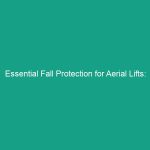Introduction
In today’s fast-paced work Environment, ensuring Safety is paramount. The Health, Safety, and Environment (HSE) framework plays a crucial role in protecting employees from Hazards, and one of the most common incidents in the workplace is slips. These accidents can lead to serious injuries, legal issues, and financial losses for businesses. Understanding how to prevent slips is essential for maintaining a safe workplace.
Slips can occur due to various reasons, including wet floors, uneven surfaces, or poor footwear. By recognizing the importance of slip Prevention and implementing effective strategies, organizations can significantly reduce the risk of these accidents. This article will cover essential tips, regulatory frameworks, best practices, and real-world case studies, providing a Comprehensive Guide to preventing slips in the workplace.
Understanding Slip Incidents
To effectively prevent slips, it’s important to understand what they are and the circumstances under which they occur. Slip incidents are typically defined as falls that happen when there is insufficient friction between the surface and the footwear. The primary causes of slips can be categorized into three main areas: environmental factors, personal factors, and organizational factors.
Environmental Factors
Environmental factors include the conditions of walking surfaces, weather conditions, and the presence of obstacles. For instance, wet or oily floors are prime locations for slips to occur. Inadequate lighting can also contribute to these accidents, as workers may not see potential Hazards in their path. Therefore, maintaining clean and dry floors, as well as ensuring adequate lighting, is essential.
Personal Factors
Personal factors involve the behavior and physical condition of employees. For example, wearing inappropriate footwear or being distracted while walking can increase the risk of slips. Training employees about the importance of proper footwear and encouraging mindfulness can help mitigate these risks.
Organizational Factors
Organizational factors revolve around the policies and Procedures in place. Insufficient Training or lack of Safety protocols can lead to an increased risk of slips. Implementing comprehensive training programs focused on slip prevention and encouraging a culture of safety can significantly reduce incidents.
Regulatory Frameworks Surrounding Slip Prevention
Understanding the regulatory frameworks that govern Workplace Safety is crucial for any organization. Various Regulations exist to promote safe working conditions and minimize hazards, including slips. In many countries, these regulations are enforced by governmental bodies that set Standards for Workplace Safety.
Occupational Safety and Health Administration (OSHA)
In the United States, the Occupational Safety and Health Administration (osha) establishes and enforces standards to ensure safe working conditions. OSHA’s regulations require employers to maintain a safe workplace, which includes taking necessary Precautions to prevent slips. Employers are expected to conduct regular safety inspections, provide appropriate training, and ensure that all Safety Measures are in place.
International Standards
Globally, many organizations adhere to similar safety regulations, such as the International Organization for Standardization (ISO). ISO 45001, for instance, focuses on Occupational Health and safety management systems, promoting safe and healthy working environments. Compliance with these standards not only helps prevent slips but also enhances overall Workplace Safety.
Best Practices for Preventing Slips
Implementing Best Practices is vital for reducing the likelihood of slips in the workplace. Here are some essential strategies that organizations can adopt:
Conduct Regular Risk Assessments
Regular risk assessments are crucial for identifying potential slip hazards in the workplace. Employers should evaluate walking surfaces, lighting conditions, and employee behavior to pinpoint areas that may pose risks. By proactively addressing these hazards, organizations can implement corrective measures before accidents occur.
Maintain Clean and Dry Floors
One of the simplest yet most effective ways to prevent slips is to maintain clean and dry floors. This involves regular cleaning schedules, prompt cleanup of spills, and the use of mats or carpets in high-traffic areas. In addition, using slip-resistant flooring materials can significantly reduce the risk of slips.
Implement Effective Footwear Policies
Footwear plays a significant role in slip prevention. Organizations should establish policies regarding appropriate footwear for specific environments. For instance, non-slip shoes should be mandatory in areas prone to spills or wet conditions. Providing employees with information on the best types of footwear for their work environment can also enhance safety.
Provide Comprehensive Training
Training employees on slip prevention is essential for fostering a culture of safety. Regular training sessions should cover the causes of slips, safe walking practices, and the importance of reporting hazards. Encouraging employees to take an active role in safety can lead to a more vigilant workforce.
Install Proper Signage
Clear and visible signage can serve as a reminder to employees about potential slip hazards. Signs indicating wet floors, caution zones, and changes in walking surfaces can alert workers to be more careful. This proactive approach can significantly reduce the likelihood of slips occurring.
Real-World Case Studies
Learning from real-world incidents can provide valuable insights into effective slip prevention strategies. Here are two case studies highlighting successful interventions:
Case Study 1: Manufacturing Plant Intervention
A manufacturing plant experienced a high rate of slip incidents, leading to injuries and financial losses. After conducting a thorough risk assessment, the management identified that wet floors in certain areas were a major contributing factor. They implemented a comprehensive cleaning schedule, installed slip-resistant flooring, and provided training on proper footwear. As a result, slip incidents decreased by 50% within six months, showcasing the impact of proactive measures.
Case Study 2: Office Environment Reform
An office building noticed several slip incidents during rainy weather. Management decided to address the issue by installing slip-resistant mats at all entrances and providing training to employees on maintaining clean workspaces. They also established a protocol for immediate cleanup of spills. These changes led to a significant reduction in slip incidents, demonstrating the effectiveness of targeted interventions in an office setting.
Challenges in Slip Prevention
Despite the best efforts to prevent slips, challenges remain. Here are some common obstacles organizations face:
Employee Compliance
One of the biggest challenges in slip prevention is ensuring employee compliance with safety protocols. Even with training, some employees may overlook Safety Measures or fail to report hazards. Organizations must foster a culture of accountability where safety is prioritized, and employees feel empowered to speak up about potential dangers.
Changing Environmental Conditions
Environmental conditions can change rapidly, making it difficult to maintain consistent safety standards. For example, wet weather can increase the risk of slips, and organizations must be prepared to adapt their safety measures accordingly. This might involve increasing the frequency of inspections or implementing temporary safety measures during adverse weather conditions.
Budget Constraints
Budget constraints can hinder an organization’s ability to invest in comprehensive slip prevention measures. However, effective slip prevention doesn’t always require large expenditures. Simple measures like regular training, clear signage, and employee engagement can be implemented with minimal costs while still yielding significant safety improvements.
Future Trends in Slip Prevention
As Workplace Safety continues to evolve, several trends are emerging in slip prevention:
Technological Innovations
Technology is playing an increasingly important role in enhancing Workplace Safety. Innovations such as smart flooring materials that provide real-time feedback about slip risks are becoming more common. Additionally, wearable technology that monitors employee movement can help identify high-risk behaviors and prevent slips before they occur.
Data-Driven Approaches
Organizations are increasingly using data analytics to identify trends and patterns in slip incidents. By analyzing data from near-miss reports and incident investigations, companies can gain insights into the underlying causes of slips and develop targeted prevention strategies. This data-driven approach enhances the effectiveness of safety programs and reduces the risk of future incidents.
Enhanced Employee Involvement
In the future, organizations are likely to place greater emphasis on employee involvement in safety initiatives. Engaging employees in the development of safety protocols and encouraging them to share their insights can lead to more effective slip prevention strategies. Collaborative approaches foster a sense of ownership and accountability, ultimately contributing to a safer workplace.
Conclusion
Preventing slips in the workplace is essential for maintaining the health and safety of employees. By understanding the causes of slips, adhering to regulatory frameworks, and implementing Best Practices, organizations can significantly reduce the risk of these incidents. The importance of employee training, maintaining clean environments, and utilizing technology cannot be overstated.
As we move forward, it is vital for organizations to remain proactive in their approach to slip prevention. By embracing innovative solutions and fostering a culture of safety, businesses can not only protect their employees but also enhance productivity and morale. We encourage you to take action today by evaluating your workplace for slip hazards and implementing the tips outlined in this article. Your commitment to safety can make all the difference.


